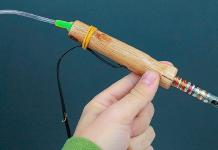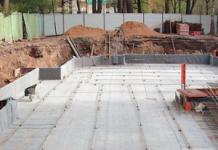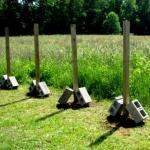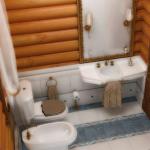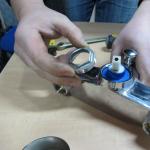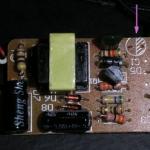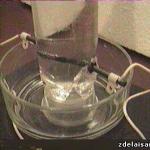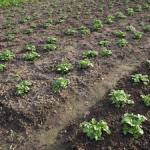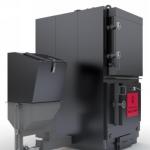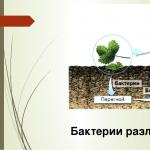The construction of the foundation is the first and most important stage in the construction of any building, so each phase of its construction is of great importance. And if no one will argue with the fact that it is impossible to save on strengthening the foundation, then opinions on the issue of its waterproofing are not so unambiguous. Some mistakenly believe that waterproofing the foundation is more desirable than mandatory. This is wrong. The lack of water protection can have an extremely negative impact on the strength of the foundation. We will tell you in this article about what types of waterproofing are used for different types of foundation and how to do it right with your own hands.
Why is foundation waterproofing necessary?
Before moving on to consider the different types of waterproofing, it is important to understand why it is so necessary.
The foundation is exposed to moisture from all sides: from the inside it is moistened by groundwater and sewage, and from the outside - by precipitation and melting snow.
The main material from which the foundation is made, namely concrete, is not afraid of moisture in itself. But it is not a waterproofing material either, therefore, moisture can both get inside the concrete and seep through it.
This is fraught with two unpleasant consequences: firstly, under the influence of moisture, the reinforcement inside the concrete can corrode and rust, which will lead to a weakening of the entire structure. Secondly, moisture, penetrating through the foundation into the structure, can become fertile ground for the formation of various fungi and microorganisms.
It is these two problems that the waterproofing of the foundation is designed to solve.
High-quality waterproofing of the foundation is the key to the reliability and durability of the building
General rules
For the installation of high-quality waterproofing, it is necessary to know not only the basic requirements for its installation, but also the features of each specific place where construction is underway.
- The foundation must be reliably protected from groundwater. If their level is above the level of the foundation, then in addition to waterproofing, it is necessary to build a drainage system.
- The blind area performs the function of protecting the foundation from external moisture.
- When installing waterproofing, it is imperative to take into account the composition of local groundwater.
For example, if so-called aggressive waters are found on the construction site, it will be necessary to use appropriate materials for waterproofing.
- You should take care not only of the foundation itself, but also of the walls in the basement and on the basement floor.
Features in the process of building a house
The most correct solution would be a waterproofing device during the construction of the foundation.
In this case, it becomes possible to protect the foundation tape not only on the sides and top, but also from below, which will be practically impossible after the foundation has already been laid.
The main feature of the waterproofing of the foundation during construction is the construction of the lower waterproofing layer, which takes on the “main blow” when protecting the structure from groundwater.
There are several technologies for creating lower waterproofing - a pillow of sand and gravel and a layer of insulating material directly.
The structure of the waterproofing pad resembles a layered cake.
As for the processing of the walls and the upper part of the foundation, any of the technologies that we will talk about can be applied during construction.
Foundation waterproofing
If waterproofing work was not carried out during the laying of the foundation, this significantly complicates the task and does not make it possible to protect the structure in full.
Waterproofing the finished foundation begins with the preparation of a trench around the entire perimeter. If this is not done, only the outer part of the tape can be processed, which will significantly reduce the protective properties of the structure.
Without preliminary excavation of the trench, waterproofing the finished foundation is almost impossible.
The depth of the trench must be at least 50 centimeters, otherwise the waterproofing of the grounded part of the foundation will be ineffective.
The surface of the foundation is checked for chips and cracks. If found, they should be repaired with a mortar, after which a layer of plaster should be applied over the entire surface of the foundation. When the plaster has dried, the selected waterproofing material is applied to it. And after the waterproofing layer has dried, the trench is buried and a blind area is arranged on top of it.
Kinds
According to its purpose, foundation waterproofing is divided into two types: anti-filtration and anti-corrosion.
Anti-filtration
Anti-filtration waterproofing is used where there are "aggressive" waters or the level of groundwater pressure on the foundation tape is high enough. For the device of this type of waterproofing, it is necessary to carefully study the characteristics of the soil and the composition of groundwater. In addition, such insulation requires complex design, so it is better to invite specialists specializing in this type of work for its installation.
anti-corrosion
Anti-corrosion waterproofing - the most common type of foundation waterproofing
Anti-corrosion waterproofing is the most common type of moisture protection that can be easily done by hand. Such waterproofing can be applied in various ways: pasting, painting, impregnation and other methods.
Depending on the type of location, there are two types of anti-corrosion waterproofing: horizontal and vertical.
Horizontal
Horizontal waterproofing serves as protection against moisture penetration into the building itself
Designed to protect the walls of the foundation from capillary absorption. As a rule, two, independent of each other, horizontal insulation systems are created: the first under the basement ceiling and the second - on top of the foundation slabs at the main anchor points.
vertical
The main task of vertical waterproofing is to protect the foundation from groundwater
It is located from the base of the foundation to the level of rainwater spray. The method of application and the thickness of such waterproofing are determined even before the foundation is built.
Water-repellent materials
Modern foundation waterproofing can be done using various materials.
Consider the most popular of them.
Bituminous mastic or, as it is also called, bituminous resin, is the most common and cheap material for waterproofing. The technology of applying mastic is referred to as coating methods of waterproofing. 7 parts of resin and 3 parts of used engine oil are placed in a large metal container. A fire is made under the container and the mixture is heated until a homogeneous mass is formed. After that, using a brush or roller, the solution is applied to the surface of the foundation.
The method of applying bituminous mastic practically does not differ from conventional painting.
Please note that hot resin can cause severe burns! When working, be sure to follow the safety regulations!
Hot mastic not only covers the foundation from above, but also penetrates into the pores of concrete, providing a fairly good level of protection against moisture.
Roll materials
This category includes several types of materials. All of them are a base that can be rolled up (hence the name), with a waterproofing layer applied to it. Roll materials can be used both independently and in combination with other water-repellent agents.
The most common of rolled materials is roofing material. It is quite easy to use and has a relatively low cost. To fix the roofing material on the walls of the foundation, it is enough to heat it up and apply it to the surface of the tape.
The most reliable way of laying roofing material is fusing
Roll materials can also include rubitex, technoelast, stekloizol, hydrostekloizol and others. Unlike roofing felt, which is based on building cardboard, these materials are made on the basis of polyester, which significantly improves their quality, but at the same time makes them more expensive.
This material is very easy to apply to any surface with a roller or brush. It has excellent water-repellent properties and, importantly, is completely non-flammable. In addition, liquid rubber allows you to make the waterproofing layer seamless, which undoubtedly improves the performance of the coating.
Liquid rubber is applied with a spray gun
Plaster and screen insulation
Such compositions allow you to simultaneously level the surface and make it moisture resistant. The principle of working with plaster waterproofing is practically the same as the process of applying ordinary plaster.
The application of plaster waterproofing is practically no different from the application of ordinary plaster.
The only difference is that the screen insulation contains water-repellent components such as hydro concrete, polymer concrete and asphalt mastics.
Modern waterproofing material, which can be attributed to the roll. True, unlike them, mats on both sides have a base of polypropylene geotextile material. Between the layers of the base there is a layer of special granules. Upon contact with water, the granules swell, forming a dense water-repellent gel.
Between two protective layers of granules, which, after contact with water, turn into a water-repellent gel
Photo gallery: materials for waterproofing
 Foundation with finished waterproofing from bentonite mats
Foundation with finished waterproofing from bentonite mats  One of the most common waterproofing materials is bituminous mastic.
One of the most common waterproofing materials is bituminous mastic.  Liquid rubber is sold in the same cans as bituminous mastic. After application, liquid rubber forms a continuous waterproof layer.
Liquid rubber is sold in the same cans as bituminous mastic. After application, liquid rubber forms a continuous waterproof layer.  Roll waterproofing based on polyester
Roll waterproofing based on polyester  Versatile material suitable for both horizontal and vertical waterproofing
Versatile material suitable for both horizontal and vertical waterproofing  One of the most reliable and durable types of waterproofing is concrete mats.
One of the most reliable and durable types of waterproofing is concrete mats.  Plaster waterproofing can be applied both with a spatula and with a regular brush.
Plaster waterproofing can be applied both with a spatula and with a regular brush.
Material Comparison
In order to make it easier for you to compare all the "pros" and "cons" of various materials, we have combined them into a table.
Table "Characteristics of materials for waterproofing"
| Material | Advantages | Flaws | Price |
Suitable for any type of foundation. Possibility to completely apply waterproofing alone. | The coating lasts no more than five years. | One of the cheapest waterproofing options. | |
| Roll waterproofing | Universal material suitable for both horizontal and vertical waterproofing. | The need for preliminary surface preparation. | A wide price range - from low (roofing felt) to high (technoelast, stekloizol). |
| Reliable waterproofing material with a long service life. | Quite a complex application technology. The need for preparatory work. | Average price category. | |
| plaster insulation | The possibility of not preparing the surface. | The need to use an additional layer of waterproofing. | Medium category, but due to savings on preparatory work, it can be classified as low. |
| One of the most reliable and durable materials. | Hardly ever. | High price category. |
Do-it-yourself waterproofing of various types of foundation
Monolithic (slab) foundation
Monolithic foundation with ready-made vertical waterproofing, made by coating method
Monolithic construction has become the most popular in recent years, so we will start considering waterproofing technologies with a monolithic foundation. Since the method of waterproofing this foundation is practically the same as protecting the slab foundation, we will combine them into one section. The only difference is that components can be added to the monolithic foundation at the pouring stage to increase its water-repellent properties.
Waterproofing of a monolithic foundation begins with a "cushion". Which, as a rule, is made of bulk material (sand, gravel or crushed stone), covered with a water-repellent layer. The walls and top of the foundation can be protected by both rolled and coated waterproofing material.
It is more preferable to use a coating material, since it, penetrating into the pores of concrete, provides a higher level of protection of the foundation from moisture.
If waterproofing is carried out with rolled materials, then they must be laid in at least two layers, with an overlap of 10-15 centimeters.
When waterproofing a prefabricated foundation, special attention should be paid to joints and seams
Moisture protection of the strip foundation has a number of features. It can also be performed using both coating and roll materials. At the same time, one should not forget about the waterproofing of the ends of the slabs, as well as the fact that before applying the waterproofing material, it is necessary to carefully repair all the joints between the slabs and the recesses and irregularities that appeared during laying.
Sealing is mandatory in all cases, except when a plaster waterproofing is used as the first water-repellent layer.
Column Foundation
In this case, the coating method of waterproofing was used.
It is a series of supports located at the corners of the walls of the building, as well as at the points of their intersection.
Waterproofing a columnar foundation is a rather complicated process. For this purpose, it is best to use a combined bulk and coating type waterproofing. That is, during pouring, special water-repellent mixtures should be poured into the foundation formwork, and after hardening, treat the surface of the piles with coating mastic.
When choosing a mastic, it is worth giving preference to a material with a penetrating effect.
Video: installation and waterproofing of a columnar foundation
When waterproofing the foundation of the bath, special attention is paid to the horizontal layer
Waterproofing the foundation of the bath requires a special approach. Firstly, when laying it, it is desirable to lay at least three layers of roofing material or other rolled material, and secondly, one should not forget about the high-quality waterproofing of the lower log of the log house. For this purpose, you can use special mastics and antiseptics, but they must be applied at least twice as thick as when building an ordinary wooden house.
Waterproofing the foundation is a rather complicated and costly process. But in no case should you save on it, because in this case you risk not only getting an “unhealthy” atmosphere in your home, but also jeopardizing its reliability. Good luck with your repair!
Very often, inexperienced builders, after erecting a foundation, neglect its waterproofing, considering this operation secondary.
As a result of further exploitation, load-bearing walls erected on such a basis begin to deteriorate. worthlessness due to constant exposure to moisture in the form of precipitation and groundwater.
What is waterproofing and is it needed?
Waterproofing means protection various materials and structures from the harmful effects of liquids on them. Main the material for the construction and foundation is concrete.
This material, despite its apparent solidity, has porous structure, so it is easily saturated with water (you can find out which concrete to use for the strip foundation).
Without waterproofing such a foundation, load-bearing walls begin to get damp and gradually break down. Applying a protective layer increases the service life of buildings and structures and significantly reduces the cost of their current and major repairs.
Types of foundation waterproofing
By appointment foundation waterproofing is usually divided into two type:
- Horizontal. Surfaces located horizontally are protected, for example, the base of the foundation, the base of load-bearing walls;
- vertical. It is applied to vertical surfaces, for example, the outer part of the plinth;
Depending on the used material protective coating distinguish the following kinds waterproofing:
- Bituminous. Bitumen of various types is used as an insulating material, depending on the weather conditions in the geographic area of construction;
- Ruberoid. Insulation is carried out using sheets of roofing material, which are stacked in several layers. When laying protection, not only roofing material can be used, but also isoplast, glassine or roofing felt;
- Liquid rubber. This material is made on the basis of bitumen. It has a liquid consistency and high elasticity, because of which it got its name.
According to the application method waterproofing is of the following types:
- Pasting;
- penetrating;
- Roll;
- Plastering;
- Spraying.
Horizontal waterproofing
 This type of waterproofing is used for guard walls and foundations. If it is planned to isolate a foundation made of concrete mortar, then the protective layer is laid before it is poured.
This type of waterproofing is used for guard walls and foundations. If it is planned to isolate a foundation made of concrete mortar, then the protective layer is laid before it is poured.
To protect the foundation, waterproofing is laid before installation concrete blocks after backfilling and its special layer of cement.
To protect the walls, a layer of waterproofing is laid throughout the perimeter of the foundation plinth after its final setting.
Horizontal waterproofing applied in almost any construction, in contrast to the vertical, which is sometimes neglected. This is due to the fact that horizontally equipped protection effectively protects the walls of the building from the effects of not only ground but also surface waters.
There are various laying methods horizontal waterproofing. Depending on the creation of the necessary degree of protection and the cost of construction, in its manufacture, special Construction Materials.
Bituminous waterproofing
 Bitumen waterproofing is used to protect concrete and metal structures. Before styling mastics the foundation is thoroughly dried, otherwise, when bitumen comes into contact with water, they will form bubbles and the waterproofing will peel off.
Bitumen waterproofing is used to protect concrete and metal structures. Before styling mastics the foundation is thoroughly dried, otherwise, when bitumen comes into contact with water, they will form bubbles and the waterproofing will peel off.
For the manufacture of bituminous waterproofing material first melt down and then applied to the work surface with a brush or brush. The thickness of the applied layer must be at least 2 mm.
It is best to use construction grades of bitumen containing special additives that prevent the destruction of the material at low temperatures.
Attention! Molten bitumen cools down literally in minutes, therefore, when working with it, it is necessary to observe time intervals, preventing premature cooling of the composition. Insufficiently melted bitumen clogs concrete pores poorly. Bitumen grades BN-3, BN-4, BN-5, BP-5, DH-1V are used for waterproofing works.
Ruberoid
 Roofing felt coating refers to highly reliable waterproofing, but such protection requires quite large material costs. Before laying the sheets, a layer of mastic is applied to the surface.
Roofing felt coating refers to highly reliable waterproofing, but such protection requires quite large material costs. Before laying the sheets, a layer of mastic is applied to the surface.
Between adjacent sheets it is necessary to overlap, at least in 15 centimeters.
Attention! Before laying sheets of roofing material, it is necessary to carefully level the surface for their laying! On an uneven surface, it will be difficult to provide the necessary overlap of adjacent sheets, and the waterproofing will be unreliable!
Plaster waterproofing
 With this method of protection, the surface is covered with a special plaster solution, which includes water-repellent additives, for example, asphalt mastic.
With this method of protection, the surface is covered with a special plaster solution, which includes water-repellent additives, for example, asphalt mastic.
The mortar is applied hot to ensure a better adhesion to the surface to be protected. The solution is applied using the same technology as for the exact alignment of the walls, using lighthouses.
Liquid rubber
 The use of this material in the manufacture of waterproofing requires both special tools and specialists. high qualifications. With this method, protection is obtained, which has high strength and wear resistance, which can be applied even in hard-to-reach places.
The use of this material in the manufacture of waterproofing requires both special tools and specialists. high qualifications. With this method, protection is obtained, which has high strength and wear resistance, which can be applied even in hard-to-reach places.
A special place in this technology is occupied by Preparation surface, which takes about a third of the total time of application of insulation. The main brands of liquid rubber used in foundation waterproofing are "Profix", "Slav", "Ultramast" And "Mastic No. 33".
The equipment with which such protection is applied are special atomizers operating both from the electric drive and on gasoline engines.
Penetrating waterproofing
This protection does not require careful surface preparation and special tools. The materials used in its manufacture are pores in concrete, making it moisture resistant. Penetrating waterproofing significantly increases term foundation service and is considered most reliable and durable.
Technology making insulation is simple - a dry mixture is purchased, for example, "Penetron", which is mixed with water according to the instructions for preparation, and then applied to the surface to be protected using, for example, a roller.
After a few hours, the mixture acquires its final properties. Penetrating waterproofing, along with its advantages, has only one drawback - high price.

Roll waterproofing
 Roll materials are often used to waterproof a building without a basement. Such insulation is made on the basis of bitumen.
Roll materials are often used to waterproof a building without a basement. Such insulation is made on the basis of bitumen.
Materials and the concrete surface itself previously heated with a gas burner, then carefully laid and, slightly pressing, smooth. Adjacent sheets are laid with an overlap 15-20 centimeters.
Spraying
This type of protection against moisture is applied using special building installations, with the help of which a thin insulating layer is laid on the surface.
Waterproofing by spraying allows you to reliably protect concrete structures from moisture and can be used in severe frosts and heat. Used as spraying material synthetic polymers - polycarbamides.
Foundation waterproofing: general rules
 To date, two types of insulation are used to protect the walls of a building from groundwater and other types of moisture - vertical waterproofing and horizontal.
To date, two types of insulation are used to protect the walls of a building from groundwater and other types of moisture - vertical waterproofing and horizontal.
Also erect additional structures, for example, install water collectors that drain moisture into special containers or channels.
Before applying the waterproofing layer, the surface must be leveled, cleaned of dirt and dust. For the best adhesion of the protective material and concrete, special primers are used.
See video lesson how to make vertical waterproofing of the foundation with your own hands:
Moisture from the soil negatively affects the durability of the foundation, and consequently, the durability of the entire structure. But how to independently protect the foundation of the house from water and what materials to use for this? You can learn about all this in detail from this article.
How to waterproof the foundation - choose a quality material
Before proceeding with the waterproofing of the base, we will briefly consider the materials that can be used for these purposes. As you know, they are of two types - coating and rolled.
For the greatest efficiency and durability of protection, they are used in a complex, i.e. first, a coating is applied, and then a roll is glued. As a result, the rolled material not only provides an additional waterproofing circuit, but also protects the coating layer from mechanical damage.
As coating materials are usually used:
- bituminous mastic is the cheapest material, which is its main advantage. The disadvantages include the duration of the application process, since this mastic dries very slowly. In addition, it is short-lived;
- bitumen-polymer mastic is a modern material that does not have the disadvantages of conventional bitumen mastic. Its service life can be several decades. The disadvantage of this mastic is one - a higher cost.
As for roll materials, you can use:
- roofing material is not the best choice due to low efficiency and fragility;
- bitumen-polymer materials (euroroofing material) - the situation with these coatings is the same as with mastics, i.e. they are much better than ordinary roofing material, but they are more expensive.
In addition, it is desirable to use a profiled membrane to protect the waterproofing from mechanical damage.
We perform vertical waterproofing
First, let's look at how to make vertical waterproofing. It is advisable to engage in this procedure even at the stage of foundation construction. If it becomes necessary to isolate the foundation of a building that is already in operation, it will be necessary to carry out earthworks and then prepare the base surface.
Waterproofing is necessary in dry, warm weather. Otherwise, you will not be able to achieve a high-quality result.

Earthworks means digging the foundation to its full depth. Make the width of the trench so that it is convenient for you to work, i.e. not less than a metre. After the trench is ready, the foundation must be left for a while so that it dries well.
If the groundwater level is high, a drainage system should be installed around the perimeter of the foundation. To do this, you need to dig a trench to a depth of 40 cm below the level of the foundation, at its very base. The bottom of the trench must be covered with a layer of sand and a layer of crushed stone with a total thickness of 20 cm. Then the trench should be covered with geotextiles. There should be a supply of canvas on the sides so that the edges can cover the pipe.
Drainage pipes are laid in the prepared trench. Please note that the pipeline should be located with a slight slope - about 2 cm per meter. On top of the pipe, it is necessary to fill up with another layer of crushed stone and then wrap it with geotextile. The drain piping should be connected to a drain well or general system.
When the foundation dries, its surface must be cleaned of dirt using a brush. If necessary, the base can even be washed with a hose and dried again. If the surface of the foundation is uneven, it should be so that the differences are no more than 5 millimeters per 2 meters. After leveling the surface, wait for the plaster to dry completely.
To further protect the foundation from moisture, it is possible to treat it with a penetrating waterproofing material, such as, for example, KtTron, before plastering. In addition, the plaster itself can also be waterproofing. To do this, use a special plaster mix.
After preparing the base, you can proceed with your own hands to waterproofing. This process largely depends on the type of materials used. If ordinary bituminous mastic is used, it must first be heated and applied with a roller, paint brush or even a spatula. True, on sale you can find ready-made bituminous mastic, which does not require heating.

The thickness of one coating layer should be several millimeters. Perform this operation carefully so that all small depressions and cracks on the foundation surface are filled with bitumen. Then wait until the first layer of mastic dries, and apply the second layer in the same way. In total it is desirable to apply 3 layers.
After all layers of mastic have dried, you can start gluing the roofing material. To do this, you need a blowtorch, with which you should heat up the back side of the roofing material before gluing. Be sure to glue the canvases with an overlap of 10 centimeters. To make the insulation last longer, stick the roofing material in two layers.
If you use a bitumen-polymer mastic, for example, "liquid rubber", the roofing material can be glued before the coating dries, i.e. without heating the back side of the canvas. The main thing is to have time to glue the roofing material before the mastic hardens. Therefore, the processing of the foundation should be carried out in small areas. Since the bitumen-polymer mastic dries within one and a half to two hours, this method of waterproofing is the fastest.
In the case of using modern roll materials, such as Techno-elast, the work is carried out somewhat differently: first of all, the foundation surface is treated with a bituminous primer, i.e. special primer. You can use a roller or brush to apply it.

Then you need to get rid of all internal even corners. They must be filled with fine-grained concrete, as shown in the diagram above. Further, it is necessary to strengthen all external and internal corners, which will increase the durability of the waterproofing material. To do this, cut the waterproofing material into strips about 10 cm wide and glue on all corners and utility entries.
In the process of vertical waterproofing, you can immediately perform its insulation. To do this, the surface should be pasted over with extruded polystyrene foam.
To stick the self-adhesive coating, it is enough to remove the protective film from the back. If the material is not self-adhesive, it must be heated like a regular roofing material. After that, you can paste over the entire foundation with waterproofing. At the same time, be sure to provide an overlap of about 30 cm. Further, the so-called edge plank is attached along the upper edge of the foundation. Use dowels to fix it. Make sure the bar is horizontal.
Install adjacent rails not close to each other, but with a gap of about 100 mm. From above, the edge strip has a bend. The space between the bend and the base should be filled with building sealant. Now it is desirable to fix the profiled membrane. You can "grab" it with dowels, hammering them over the edge bar.
To provide additional protection for the foundation from moisture, lay clay in the trench.
This completes the work. Now it remains to fill the trench with soil and make a blind area that drains rainwater from the foundation. In the process of pouring the blind area, it is also desirable to waterproof it. To do this, it is necessary to lay a waterproofing material under the screed with a twist on the foundation.
If the house has a basement, it is advisable to waterproof its walls from the inside in the same way as the foundation from the outside. The only thing is that a profiled membrane is not needed for internal waterproofing, because the walls from the basement side are not subjected to mechanical stress.
Protection of walls and foundations from moisture - horizontal waterproofing
To protect the walls from capillary suction of moisture from the soil, horizontal waterproofing of the foundation is performed. It can be done only at the stage of building a house. Its principle is based on the fact that the walls are isolated from the foundation.
I must say that if only the strip foundation is subjected to vertical waterproofing, then the horizontal one is always performed, regardless of the type of foundation structure.
The work is carried out quite simply: mastic is applied to the surface (the same as for vertical waterproofing). After the mastic dries, several layers of roofing material are laid. Further, the walls of the house are erected on top of the roofing material.
Here, in fact, are all the main nuances of waterproofing. As you can see, in general, the operation is quite simple, but at the same time extremely necessary.
One of the important conditions during construction is the protection of the supporting part from moisture. The problem is exacerbated by the fact that technology violations in this case are difficult to control without extracting the foundation. It may happen that during the operation of the purchased house, problems were discovered. Or another situation: the building was built in compliance with all standards, but it already has a fairly long service life and needs repair. In all these cases, it will be necessary to perform waterproofing of the foundation with your own hands on an already built house.
Isolation methods
There is no mention of additional measures such as foundation drainage or drainage. These measures relate to protecting the foundation from moisture, but, in fact, are not insulation. It is important that without these works, waterproofing can be meaningless, so you should not forget about them.
The foundation must be reliably protected from water
The main problem arises for strip foundations in houses with a basement. The need for isolation may arise in the following cases:
- violation of technology in the construction of a house(neglect of waterproofing or its insufficient quality);
- material degradation over time(aging, repair required);
- groundwater level rise, as a result of which the strip foundation of the house is flooded in the presence of a basement.
Depending on the cause of the problem and its size, choose the appropriate option from the following:
- coating vertical insulation;
- rolled vertical insulation;
- penetrating waterproofing;
- injection protection of the foundation of a built house;
- use of diffusion membranes;
- mounted methods.
Waterproofing device, if it is missing, insufficient or out of order
Here it is extremely important to find out one thing: the insulation system is completely absent or only vertical protection has been neglected. It is worth noting that if the horizontal laying of the material was not provided for during construction, nothing can be done about it without dismantling the foundation of the house.
To eliminate the dampness of the basement and prevent the destruction of structures, work can be done from the inside or outside. The first option is more time consuming, since you will have to dig out the soil around the perimeter of the building, but more correct.
Moisture protection from the outside
In order to repair insufficient waterproofing or correct the situation in its complete absence by an external method, work is performed in the following order:
 External way to protect the base from moisture
External way to protect the base from moisture - Digging out the foundations from the outside.
- If there is no drainage around the perimeter of the strip foundation, you need to do it yourself. The location of the pipes in the ground is prescribed in such a way that they are 30-50 cm lower than the sole of the base and are no further than 1 meter from the basement walls.
- The next step is to assess the condition of the foundation. If there are significant damages, they must be repaired. Seal up cracks, crevices and sinks with a cement-sand mortar. In case of serious defects, it may be necessary to strengthen the strip foundation of the house. The execution of such work depends on the degree of damage. If there are problems only on the surface, it will be enough to shotcrete, if the situation is more serious, do it yourself by expanding the sole or unloading the supporting part of the house.
- Next, you need to choose a method of waterproofing. The cheapest option is bitumen coating. But this protection is suitable for low soil moisture and is not durable. The same can be said about the roofing material (roll pasting material). It is better to repair the strip foundation using more modern materials, such as linokrom, hydroisol, glass isol, diffusion membranes.
- After the walls of the basement of the house are sheltered from moisture, you can build a brick wall around the perimeter. This will become an additional barrier in the ground. Having finished with waterproofing work, backfill with layer-by-layer compaction is performed.
- The last stage of waterproofing is a do-it-yourself blind area.
Moisture protection from the inside
Do-it-yourself fragment of the strip foundation of the house is a labor-intensive undertaking. If it is not possible to perform waterproofing measures from the outside, then the option remains from the inside. In this case, you do not have to work in the ground. The repair of the foundation is carried out from the side of the basement.
The easiest option in this case is the use of coating and roll materials. The method will not require large expenditures, but will be ineffective. Such actions will prevent water from entering the basement, but the construction of the strip foundation of the house will not be protected.
 Protection of the basement from moisture from the inside
Protection of the basement from moisture from the inside It is better to give preference to more effective measures when doing waterproofing with your own hands:
- use of penetrating materials;
- injection.
The effect of penetrating insulation is that the composition, getting into the thickness of the foundation of the house, crystallizes in the capillaries and prevents the penetration of water. Repair in this case will be quite effective, since the thickness of the walls of the basement of a private house rarely exceeds 60-70 cm, and some manufacturers claim that their compounds are able to penetrate to a depth of 90 cm. In this case, when performing work from the inside, even that part of the structure that is in the ground. Another advantage of this method is its low labor intensity. The disadvantage is the rather high cost of materials for processing.
 An effective and simple method of base protection
An effective and simple method of base protection Injection is a more efficient method than the previous one, but will require more labor. At the same time, the soil is strengthened around the basement walls. This means that not only the waterproofing is repaired, but also the supporting part of the house is strengthened. The work process begins with the introduction of injectors through pre-drilled holes to the outer edge of the basement walls. Through them, a solution for amplification will be supplied. The distance between the holes is assigned depending on the permeability of the soil and the viscosity of the composition for strengthening.
As mixtures for injection can be used:
 Injection allows you to strengthen the supporting structure
Injection allows you to strengthen the supporting structure
- polyurethane foams;
- various resins;
- acrylate gels;
- liquid rubber compounds;
- cement-based mixtures;
- combinations of polymers.
If you need to strengthen the base at the same time as insulation, then cement-based mixtures are suitable. When solidified, they turn the soil into a solid stone foundation. The bearing capacity of the soil is thus significantly increased. Even if the foundation is damaged, this will not lead to uneven shrinkage and cracking.
What to do when the groundwater level rises
 High water protection
High water protection Compared to the previous problem, this one can bring more trouble and require more serious investment. The way out in this case will be reliable drainage and dewatering. If the foundation is exposed to pressure, it is necessary to isolate not only the base, but also to repair the basement.
In addition to strengthening the insulation from the outside, additional measures will be required on the inner edge of the walls. In this case, caissons are often equipped, but construction can be started only after moisture has been prevented from penetrating the foundation, performed in one of the following ways:
- roll materials with additional protection (for example, the construction of brick walls around the perimeter of the supporting part of the building);
- diffusion membranes (you need to choose those that have a perforated surface, they are designed for vertical protection);
- penetrating compounds;
- injection.
The most reliable, but extremely expensive method will be repairs using steel wall cladding from the inside.
For work, sheets with a thickness of 4-6 mm are taken.
 The most reliable basement protection
The most reliable basement protection First, they are cut and fixed on the surface of the floor and walls (on vertical structures, they should be taken out just above the groundwater level). The sheets are fastened together by welding. To the floor and walls - with the help of special anchors. They are driven in such a way that a small space remains between the protected surface and the steel sheet, which is filled with cement mortar through the holes in the sheets. After completion of work, these holes are closed with steel plates for welding.
